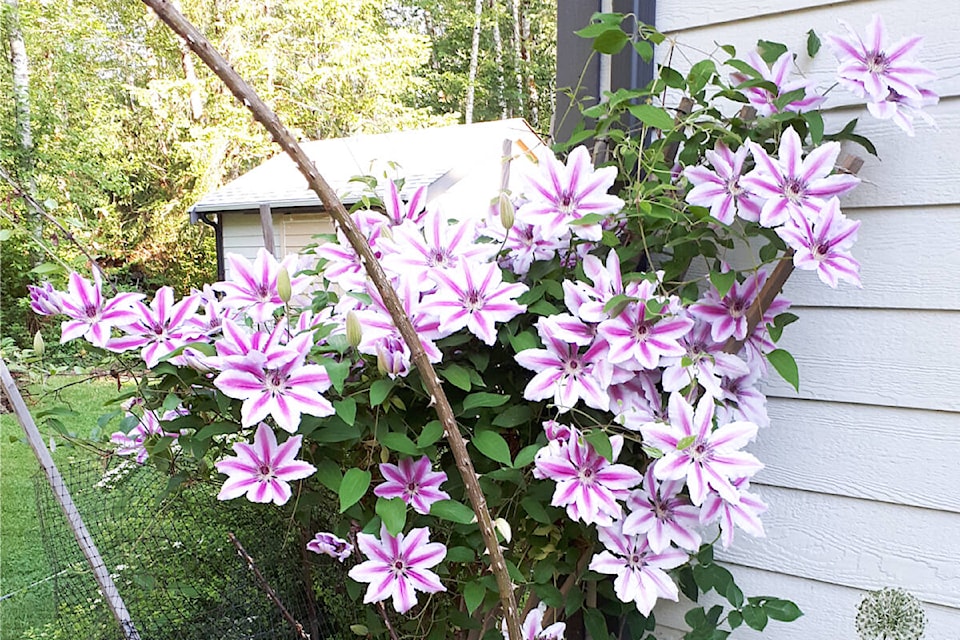By Marion Waters
No wonder we rejoice when spring begins, with its parade of flowers to cheer us. One flower that always gives me joy is my Clematis ‘Nelly Moser.’
Growing on woody vines, clematis can be directed to places that ground dwellers can’t reach, adding vertical interest to your garden. Abundant blooms create a burst of dazzling colour - up trellises or porch beams, along fences, over shrubs, or even twining up a tree.
Clematis are generally hardy and easy to grow. Dozens of varieties offer a myriad of shapes, colours, and sometimes fragrances. Some produce interesting seed pods that rival the beauty of the flowers. Vines can grow as long as 15 m (50 ft.)! Plant clematis about 8 cm (3 in) deep in an area that is protected from sun, wind, and animals (especially deer) in fertile, well-drained soil. The vines will climb to find the sun. Deciduous vines can be tangled and unsightly after blooming is finished so it’s wise to tuck them in behind other shrubs. Plant in spring or early- to mid-autumn. Apply lime if soil is acidic. Mulch around the plants year-round.
Clematis plants fall into three categories. Early-flowering species bear flowers on the previous year’s shoots in early spring. After flowering is finished, they can be cut back to fit the space. This will encourage new growth for next year’s blooms. Early-to-mid-season clematis produce large blooms on side shoots arising from the previous year’s growth and bloom again in mid- and late summer on the tips of the current year’s shoots. Prune the same as for the early-flowering varieties but wait until fall when all blooming is finished. For both of these groups, you can also thin out an overgrown plant by cutting a few old stems to the ground. Late bloomers produce large blooms on the current year’s shoots in summer and early autumn. After blooming, cut back all of the previous year’s stems to a pair of strong buds, 15-20 cm (6-8 in.) above ground level. For all species, remove dead and damaged branches while pruning. If you are not sure which category your clematis falls into, watch its blooming habits for a year and you should be able to figure it out.
Another way clematis is clever is in how it propagates through a process called layering. Vines that lie on the ground become covered with fallen leaves and debris and begin to take root. (Yes, it’s that simple!) If you carefully dig up the rooted vine and snip it off on either side of the roots, you will have a whole new plant. In fact, last season I had so many of these new vines starting that I had to pull many of them out because they were encroaching on other shrubs nearby. You can assist the layering by placing a vine on the ground in the early spring and covering a portion of it with soil. Make sure the section you are covering includes some leaf buds because the roots will emerge from the leaf notches. Allow several months for the roots to develop before you dig up your new plants.
Most clematis plants are deciduous but there are also evergreen varieties, the most common being ‘armandii’. Its leaves are darker and waxy. Because the greenery can be enjoyed year-round, these varieties don’t need to hide behind a bush! They can arch over gates and doorways, wafting their sweet fragrance over all who pass under them.
A creative idea is to plant selected colour varieties side by side and allow them to twine together to create striking colour combinations. Another idea is to plant a variety from each of the three categories, either in the same area or at different focal points, and have clematis blooming throughout the season. Now that would be clever!
Marion Waters is a retired educator. She is a writer, soap-maker, and lifelong avid gardener and a Master Gardener. She lives on a hobby farm in Black Creek. For more see: marionwaters.ca
